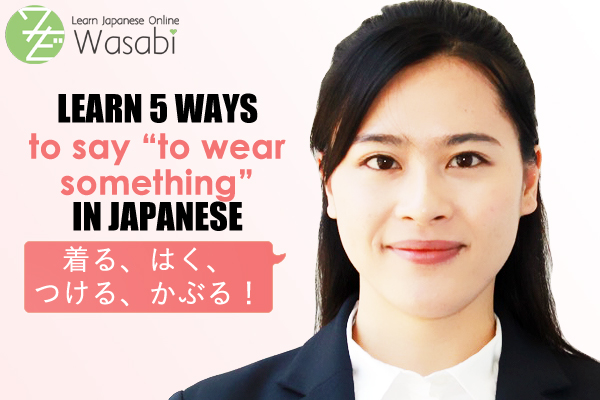5 Ways to Say “To Wear Something” in Japanese
Welcome back to our “Video & Article” series with tutor Miki. In this article and video Miki teaches five different verbs that all mean “to wear” in English. Japanese uses different verbs meaning “to wear” or “to put on” depending on the type of clothing or accessory that you put on. Learn the five most common ways to say “to wear” and the according clothing type!
| Table of Contents [Introduction] [着る] [履く] [かぶる] [かける] [する] [つける] [To take off] |
[Introduction]
While you can usually use “to wear something” for mostly any type of clothing in English (shirts, trousers, shoes, sunglasses…), that is not the case in Japanese. Japanese has a variety of verbs that mean “to wear”, depending on the type of clothing or accessory you are referring to. At the end of the article we will also briefly take a look at how to say “to take something off” in Japanese.
[adsense]
[着る]
“着る” is the most basic expression meaning “to wear” in Japanese, and most likely the first you will come across when learning Japanese. “着る” can be used for three different types of clothing: Clothing that is worn on the upper body such as t-shirts or jumpers, clothing that touches your shoulders like dresses, and pajamas.
Examples:
Tシャツを着る。
To wear a t-shirt.
ワンピースを着る。
To wear a dress.
パジャマを着る。
To wear PJs.
To mark the object you are wearing you use “を” with “着る”, since this marks a direct object in a sentence. The direct object upon which the action of the verb is directed must be the noun right before “を”, so the sentence structure is
Object を Verb.
[履く]
The next verb is “履く”, which is mainly used for clothing worn on the lower body. “履く” describes the action of putting your feet through a piece of clothing, so this can be used for jeans, trousers, skirts, shoes, and socks.
Here are some examples:
ジーパンを履く。
To wear a pair of jeans.
ズボンを履く。
To wear trousers.
スカートを履く。
To put on a skirt.
靴を履く。
To wear a pair of shoes.
Let’s look at examples.
靴下を履く。
To wear socks.
[かぶる]
The next verb on our list today is “かぶる”. “かぶる” literally means “to cover (something)”. So when not used in connection with clothing or accessories, “かぶる” can also be used like this:
雪をかぶった庭。
A yard covered in snow.
Hence, the verb “かぶる” is used for items that you use to cover your head with, for example hats, caps, or wigs.
帽子をかぶる。
To wear a hat.
For wigs, there are two different words in Japanese: “カツラ” and “ウィッグ”. “カツラ” is the type of wig that is used by actors or for dolls, and wigs that aren’t for the purpose of being fashionable. “ウィッグ” on the other hand refers to fashionable and trendy wigs.
カツラをかぶる。
To wear a wig.
ウィッグをかぶる。
To wear a wig.
[かける]
For glasses, sunglasses, and shades you use the verb “かける”. The literal meaning of “かける” is “to hang”, so this refers to items like glasses that you hang onto your ears and nose bridge.
メガネをかける。
To wear glasses.
サングラスをかける。
To wear sunglasses/shades.
[する]
To make things simple, you can use the verb “する” for small accessories like watches, necklaces, ties, gloves, and rings. Technically, each type of item has its own verb that goes with it, but using “する” is no problem in conversation.
時計をする。
To wear a watch.
ネックレスをする。
To wear a necklace.
ネクタイをする。
To wear a tie.
手袋をする。
To wear gloves.
指輪をする。
To wear a ring.
[つける]
For perfumes and colognes, you can use the verb “つける”, which can be translated to “to apply”, or “to attach”, or “to stick (something to something)”.
The Kanji for “つける” looks like this:
付ける
The left radical of the Kanji “付” shows a person (人), and the right side a simplified hand (手). This symbolizes the act of sticking one thing onto something else.
香水を付ける。
To wear perfume/cologne.
香水を付けてる人好き?
Do you like people who wear cologne?
今日香水付けすぎた!
I put on too much perfume today!
[To take off]
Now that we’ve learned various ways to express “to wear” in Japanese, let’s briefly go over how to say “to take off”, or “to undress”. There are only two verbs, so it’s easier to remember than the other way around!
For all clothing worn on the upper and lower body, including shoes, socks, hats, and wigs, you can use the verb “脱ぐ”.
ジャケットを脱ぐ。
To take off a jacket.
靴を脱ぐ。
To take off your shoes.
For accessories such as glasses, watches, gloves, and so on you can use the verb “はずす”.
メガネをはずす。
To take off your glasses.
ネクタイをはずす。
To take off your tie.
スカーフをはずす。
To take off your scarf.
That is all for today’s lesson! If you have any questions about this topic, don’t forget that you can always book a lesson with our qualified Japanese tutors.





